Trump’s Federal Workforce Goals: Streamline Firing, Automate Jobs
New cross-agency priorities detail metrics that the administration will use to implement workforce agenda.
The Trump administration on Tuesday detailed its specific goals for overhauling the federal civil service system, including efforts to streamline the firing of poor performers and to speed up the hiring process for senior executives.
The proposals and corresponding metrics were released Tuesday under the “workforce for the 21st century” cross-agency priority goal. The Trump administration unveiled its CAP goals as it released its president’s management agenda, updating the priorities for the first time since it directed agencies to no longer work on Obama-era goals. The Office of Management and Budget announced 14 CAPs with the new agenda, one of which focused on “enhanced alignment and strategic management of the federal workforce.”
The goals focused on updating a personnel system that the administration called “a relic of an earlier era.” The pillars of that update will revolve around improving performance management and engagement, reskilling and redeploying employees, and simplifying hiring.
“Both employees and managers agree that the performance management system fails to reward the best and address the worst employees,” the administration wrote in the management agenda. “With annual civilian personnel costs of almost $300 billion, the government should always be seeking to ensure its workforce has the right skills, is the right size, and operates with the responsiveness and flexibility needed to best accomplish its various missions.”
By March 2019, the administration is requiring all agencies to remove all steps in the disciplinary process not formally written in law. That would result in all agencies maintaining a consistent approach to punishment, OMB said. By December of this year, the Office of Personnel Management and the Defense Department will come up with “the most promising policies and procedures” to address poor performance. By September of next year, all managers will receive training on dealing with performance and conduct issues. Just before that, OPM and the General Services Administration will begin sending “parachute teams” into agencies to assist them in dealing with performance management issues.
“We make it too hard to hire, too hard to reskill and, yes, too hard to deal with poor performers,” OMB Deputy Director for Management Margaret Weichert said during a rollout for the management agenda in Kansas City, Mo., on Tuesday.
The new priorities come after President Trump in his State of the Union address in January called on Congress “to empower every Cabinet secretary with the authority to reward good workers—and to remove federal employees who undermine the public trust or fail the American people.”
Agencies will “identify leading practices” on using incentives to reward and recruit employees, such as performance awards and skill-based bonuses. Agencies must demonstrate by June an “initial capability” with automation in the hiring process and later determine the best practices in alternative personnel systems that agencies have piloted. Next year, OPM will develop an alternative to hiring Senior Executive Service employees aside from the current process of bringing all SES candidates before a qualifications review board.
By the end of this year, the administration will identify three areas the government can automate and create pilot programs to start that conversion. It will then develop a plan for those employees who lose their jobs from automation to reskill them and match them with existing vacancies. OPM has set individual goals of enabling paperless employee transfers between agencies and improving the certification of federal human resources professionals.
The administration will not be able to accomplish all of its goals unilaterally. In his budget and again in his management agenda, Trump called for moving away from across-the-board pay raises and near automatic step increases and toward a pay-for-performance system. The White House has asked lawmakers to create a $1 billion “interagency workforce fund” in fiscal 2018 for “targeted pay incentives” for employees. OMB said it would “partner with Congress” to overhaul statutes and regulations in need of updating.
In addition to pay reforms, the management agenda reiterated a proposal to alter the retirement benefits federal employees receive. Newly sworn in OPM Director Jeff Pon said in Kansas City on Tuesday that requiring feds to wait five years to vest into their pensions “just doesn’t make sense” for the modern workforce. The administration has proposed moving away from pensions altogether and toward a defined-contribution only system.
While many former government management officials and watchdog approvals praised Trump's new agenda, federal employee representatives were less than thrilled with some of the specifics. Tony Reardon, president of the National Treasury Employees Union, said the reforms would lead to "unfair, arbitrary and less consistent performance management." He added the goals displayed a "lack of understanding" of the real workforce issues facing agencies, such as understaffing, inadequate compensation and insufficient training.
"NTEU stands ready to help with innovations that make the federal government run more efficiently and effectively for taxpayers," Reardon said. "However, we remain suspicious of any proposed reforms that appear to have as their end goal a weaker government staffed by more private contractors and fewer, less-skilled public servants."








